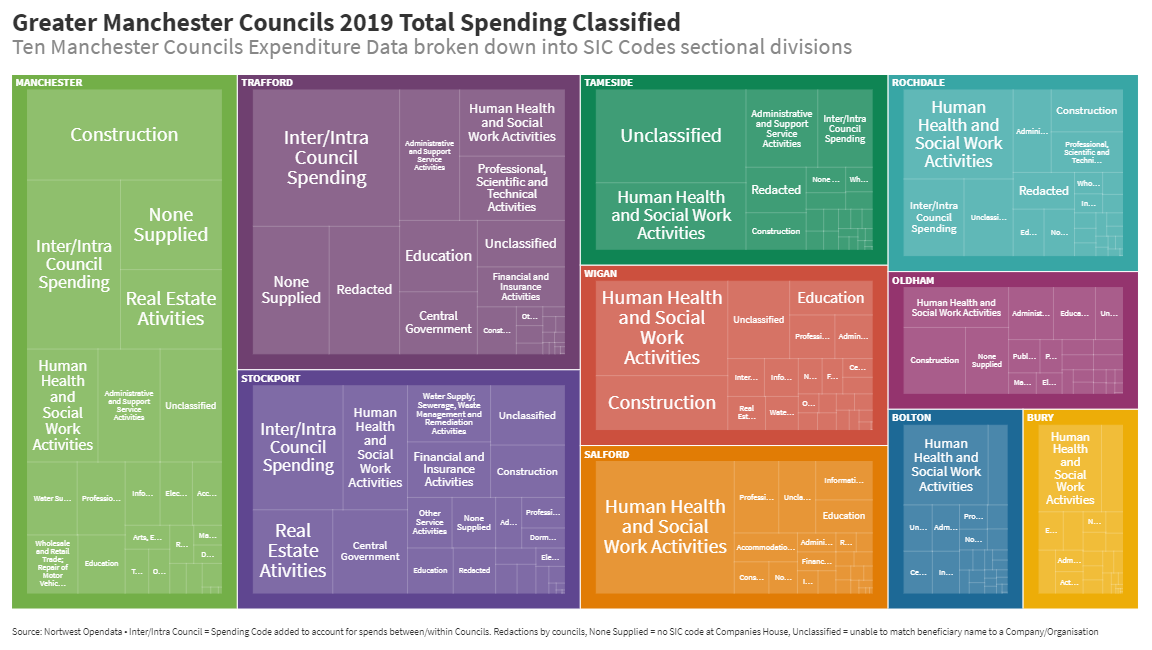So What’s Wrong With Council Spending Data? Part III

Part 2 : A look at Data Scope and Categories in local government spending data
1. Introduction
Having spent the last few months collecting Local Government spending data for most of the councils in the North West of England I thought I’d collect together in a series of posts some of the technical issues I’ve encountered compiling the data sets. In Part I I I looked at issues related to CSV file formats and date reporting, in Part II I covered payment amounts and beneficiary names. In this part I will look at the scope of the data and touch on category information and why it doesn’t really help comparing individual councils.
2. Data Scope
The Section 2, paragraph 28 Transparency Code states that the following items must be published
-
individual invoices
-
grant payments
-
expense payments
-
payments for goods and services
-
grants
-
grant in aid
-
rent
-
credit notes over £500, and
-
transactions with other public bodies
The Local Government Association includes the above but adds the following specific exclusions
-
transactions relating to income or the financing or underwriting of debt
-
financing and investment expenditure
-
payments made to Her Majesty’s Revenue and Customs (HMRC) for value added tax (VAT), pay as you earn (PAYE) and National Insurance Contributions (NIC) or pensions.
-
salary payments to staff (this is covered separately by the Code)
-
compensation payments to individuals.
Having worked with several councils spending datasets from 2019 it occurred to me that equivalent councils have a different ‘feel’ to them. I think I first noticed this with ‘Teachers Pension’ payments, a few councils reported these most did not.
I have a suspicion that councils do not report the same items and think the easiest way to demonstrate that hypothesis is by looking at payments to Her Majesty’s Revenue and Customs, what should be excluded is specified in the above LGA guidance.
To demonstrate some of the problems working with these datasets, HMRC appears in many forms which need to be resolved to a single name for comparison across councils
original_name | match_company_name -----------------------------------------------+------------------------ H M REVENUE & CUSTOMS | HM REVENUE AND CUSTOMS H M REVENUES AND CUSTOMS | HM REVENUE AND CUSTOMS HM REVENUE & CUSTOMS | HM REVENUE AND CUSTOMS HM REVENUE & CUSTOMS LOCAL COMPLIANCE | HM REVENUE AND CUSTOMS HM REVENUE & CUSTOMS ONLY | HM REVENUE AND CUSTOMS HM REVENUE & CUSTOMS ONLY#WAS INLAND REVENUE#2 | HM REVENUE AND CUSTOMS HM REVENUE AND CUSTOMS | HM REVENUE AND CUSTOMS HM REVENUES & CUSTOMS | HM REVENUE AND CUSTOMS HM REVENUES AND CUSTOMS SHIPLEY | HM REVENUE AND CUSTOMS HMRC | HM REVENUE AND CUSTOMS HMRC SHIPLEY | HM REVENUE AND CUSTOMS HMRC#CIS | HM REVENUE AND CUSTOMS INLAND REVENUE | HM REVENUE AND CUSTOMS INLAND REVENUE - CHAPS | HM REVENUE AND CUSTOMS INLAND REVENUE ONLY | HM REVENUE AND CUSTOMS
Once that’s is done you can view payments
| org_short_name | company_name | total | count |
|---|---|---|---|
allerdale |
HM REVENUE AND CUSTOMS |
126411.36 |
11 |
bandd |
HM REVENUE AND CUSTOMS |
23100786.42 |
188 |
barrow |
HM REVENUE AND CUSTOMS |
23049.68 |
12 |
bolton |
HM REVENUE AND CUSTOMS |
11626624.52 |
13 |
bury |
null |
0 |
0 |
carlisle |
HM REVENUE AND CUSTOMS |
1941.89 |
2 |
cheseast |
null |
0 |
0 |
cheswest |
HM REVENUE AND CUSTOMS |
2825.00 |
1 |
copeland |
null |
0 |
0 |
eden |
null |
0 |
0 |
halton |
null |
0 |
0 |
knowsley |
HM REVENUE AND CUSTOMS |
27718.88 |
10 |
liverpool |
HM REVENUE AND CUSTOMS |
9194.68 |
1 |
manchester |
HM REVENUE AND CUSTOMS |
130644.44 |
17 |
oldham |
null |
0 |
0 |
rochdale |
HM REVENUE AND CUSTOMS |
1406958.00 |
10 |
salford |
HM REVENUE AND CUSTOMS |
748.41 |
1 |
sefton |
null |
0 |
0 |
southlakes |
null |
0 |
0 |
sthelens |
HM REVENUE AND CUSTOMS |
82200.00 |
1 |
stockport |
HM REVENUE AND CUSTOMS |
48933891.39 |
679 |
tameside |
HM REVENUE AND CUSTOMS |
5781.17 |
2 |
trafford |
HM REVENUE AND CUSTOMS |
38152822.24 |
151 |
warrington |
HM REVENUE AND CUSTOMS |
502395.49 |
17 |
wigan |
HM REVENUE AND CUSTOMS |
828500.91 |
31 |
wirral |
HM REVENUE AND CUSTOMS |
450090.00 |
4 |
Eight councils out of 26 record no payments to HMRC, of the councils that do record payments they vary from £748 to nearly £49 million, is this variance in amounts credible, to me it seems unlikely, looking at the number of payments over 2019, there is a rough correlation between amount paid and number of payments. Let’s take a closer look at some council payments to see if there is some category information that might shed some light on what the payments are and if they are actually items that should be excluded.
Let’s take a closer look at Trafford, which has 151 payments totalling £38,152,822.24
SELECT DISTINCT( b.expense_type ),
o.company_name,
SUM(o.amount)
FROM organisation_expenditure_v2 o,
trafford_spend_2019 b
WHERE o.company_name = 'HM REVENUE AND CUSTOMS'
AND o.org_short_name = 'trafford'
AND o.nwod_id = b.nwod_id
GROUP BY b.expense_type,
o.company_name
ORDER BY SUM(o.amount);
expense_type | company_name | sum
----------------------+------------------------+-------------
Statutory Pay | HM REVENUE AND CUSTOMS | -944091.77
RENT OF PREMISES | HM REVENUE AND CUSTOMS | 7059.00
SITE PURCHASES | HM REVENUE AND CUSTOMS | 29600.00
CI TAX NET CLEARING | HM REVENUE AND CUSTOMS | 218621.07
Apprenticeship Levy | HM REVENUE AND CUSTOMS | 501554.00
TLCIC BACS BUREAU DR | HM REVENUE AND CUSTOMS | 684820.72
Student Loans | HM REVENUE AND CUSTOMS | 978839.00
PAYE Tax | HM REVENUE AND CUSTOMS | 13834471.71
Nat Ins & Rebate | HM REVENUE AND CUSTOMS | 22841948.51
(9 rows)From the above query we can see that National Insurance and PAYE payments are included totalling nearly £37 million. Stockport doesn’t provide any meaningful categorisation of the HMRC payments. Blackburn with Darwin include NI payments including deductions and employer contributions. Other items appear in these and many councils payments to HMRC
-
Student Loans payments
-
Apprenticeship Levy payments
-
State maternity payments – effectively as refunds
-
Construction Industry Scheme(CIS) payments
It is unknown if the above items should be reported under the transparency code or the LGA guidance. When you also consider the Expenditure Range issue highlighted in Part II of these posts I think it would not be unfair to say the lack of consistency across councils makes the spending data less than useful for cross council comparisons.
3. Category Data
Councils are required to provide a ‘merchant category(eg. computers, software etc)’ presumably to provide a high level of classifying the purpose of payments, sounds great doesn’t it? The LGTC does not expand on this. The LGA guidance mentions ‘Procurement classification / merchant category’ and suggests using either
-
Proclass – is local government owned and is made freely available to any UK public sector organisation
-
The Common Procurement Vocabulary(CPV) – A European Commission standard code system for public procurement.
I’ve seen references in the raw data files to two other classification methods
-
CIPFA/SeRCOP(was BVACOP) – Chartered Institute of Public Finance and Accountancy proprietary system, it is required when reporting to Central Government
When researching around the subject I’ve seen the following systems mentioned
-
Local Government Service List(LGSL) – maintained by LGA
-
https://www.ungm.org/Public/UNSPSC[United Nations Standard Products and Services Code}(UNSPSC)
3.1. Observations
-
Some councils produce no category data eg. Rochdale, Sefton and Wirral
-
Some councils use a subjective system, either they create their own or tailor an existing one for specific local requirements, for example Bolton, see below for some of their categories
45615 - Agilisys - Transformation Contracted Services Contracted Services - Bolton Care and Support Ltd Corporate Training Fujitsu Data N/wk Line Rent Fujitsu Data N/wk Mngmnt Fujitsu Managed Service
-
St Helens claims to report CIPFA data but the columns are empty
-
Cheshire East report 3 levels of Proclass code and a Thomson classification
-
Other councils report just one level of Proclass and lets the user figure out which it is, and it won’t be the same as the adjacent council.
-
There is usually no metadata explaining what system is being used and the column headings may not be helpful
-
There appears to be a blurring of definitions with this item, are they meant to be
-
A vendor classification
-
A financial or accounting classification
-
A business area classification
-
The approach I took was to use the Companies House SIC Code for the companies I had identified, this obviously leaves some expenditure unclassified and unclassifiable. I did create one category here ‘Inter/Intra Council Spending’ which represents the money flow between different local authorities. Here’s an example of an attempted comparison of the Greater Manchester Councils expenditure
4. Conclusions
-
Local authorities make payments to a huge range of suppliers, these may be commercial, charitable, governmental or even individuals via possibly multiple payment systems, when reporting it is not unsurprising that the scope of what is reported in the absence of precise definitions may result inconsistencies when comparing between councils.
-
Clearer guidance could be provided by the LGA or government in future editions of the transparency code.
-
The current situation where councils may or may not provide category data, or provide different category classifications or different levels of the same category systems makes cross council comparison virtually impossible.
-
SIC codes provide a slightly better solution but large areas of payments fall out of SIC classification.
That’s the final post looking at some of the quality issues associated with this data, overall I think the spending dataset is important for transparency purposes. I don’t think it would be difficult to improve the overall quality and comparability but I doubt there is much will to make the required changes.
